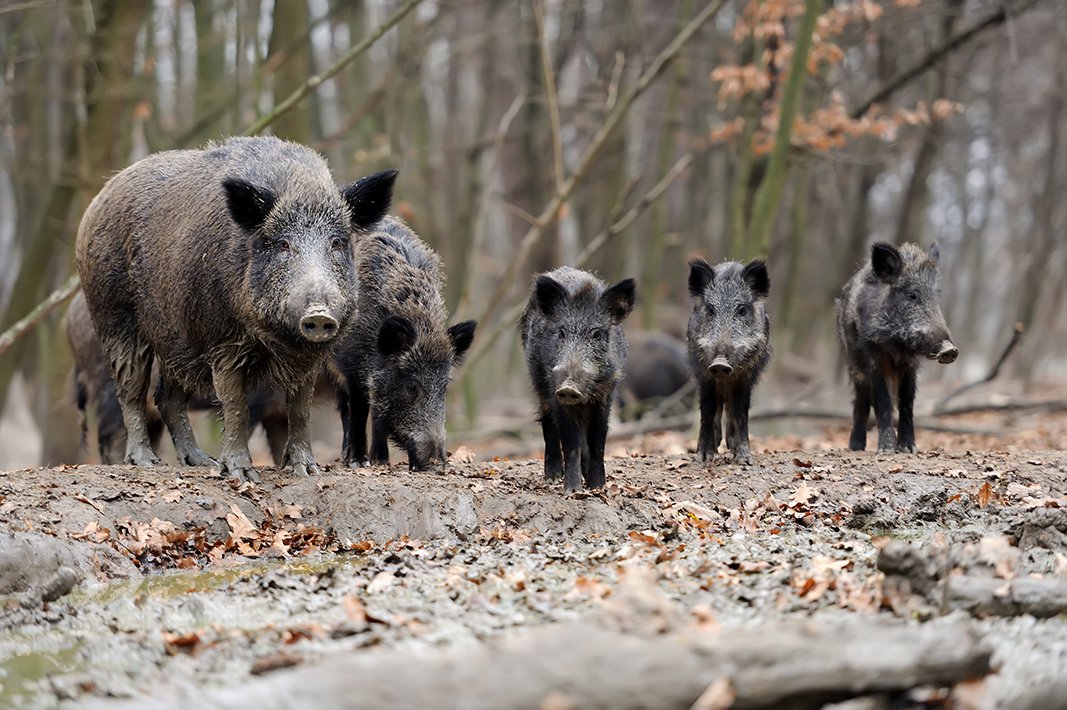What Can Pigs Teach Us About Adaptation and Populations?
Genetic variation in pigs allows them to adapt to environmental changes and increase survival.
Objectives
Students will determine if feral pigs are an invasive species.
Students will explain how the traits of feral and wild pigs aided their population growth.
Students will simulate the population growth of wild pigs in the southern United States.
Students will make predictions for what factors will affect wild pig populations.
Students will develop a plan for controlling wild pig populations.
Kentucky Academic Standards
NGSS
MS-LS4-4. Construct an explanation based on evidence that describes how genetic variations of traits in a population increase some individuals’ probability of surviving and reproducing in a specific environment.
MS-LS2-1. Analyze and interpret data to provide evidence for the effects of resource availability on organisms and populations of organisms in an ecosystem.
MS-LS2-4. Construct an argument supported by empirical evidence that changes to physical or biological components of an ecosystem affect populations.
ELA/Language Arts Standards
RST.6-8.1 Cite specific textual evidence to support analysis of science and technical texts.
RST.6-8.7 Integrate quantitative or technical information expressed in words in a text with a version of that information expressed visually (e.g., in a flowchart, diagram, model, graph, or table).
WHST.6-8.1 Write arguments to support claims with clear reasons and relevant evidence.
WHST.6-8.9 Draw evidence from literary or informational texts to support analysis, reflection, and research.
Supplies/Resources
Colored tiles or beads (200) and a bag for each group - Instructions below OR use this template to print on one sheet each red and blue paper for each group.
Instructions/Teacher Suggestions
Interest approach suggestion: Visit https://guide.sportsmansguide.com/10-huge-hogs-you-have-to-see-to-believe/. Do your students believe these hogs are real or photoshopped?
Ask students to read the article on wild pigs or research wild pigs on their own and complete the student lab worksheet. Scenario: They are wildlife biologists researching how quickly populations of whitetail deer and wild pigs will multiply in a controlled environment. Students will begin their simulation with 5 males and 5 females of each species to encourage genetic diversity. There will be an average mortality (death rate) of 40%. This number was suggested by wildlife tracking studies of both species, where predation is generally low compared to smaller wildlife.
For the population simulation activity, you may use the kit available by request (email jennifer@teachkyag.org), or you may create your own:
Each “grab bag” should contain 200 small wooden tiles, paper chips, beads, or pom poms. We have provided a printable template with 100 tiles. You will need:
60 blue (male)
60 red (female)
80 black (animals that do not survive)
Once students have their starting populations - 5 male and 5 female - they will draw a random number of tiles equal to the number of females for each generation. Remind students that does typically have one fawn per year, while sows may have two or three litters per year. This is why the pig population table has 6-month marks.
Any black tiles will be set aside and are not counted in the totals for each generation.
Students will continue to draw tiles until they reach a total population of 100 (when they are close, they may run out of tiles) or until they reach generation 10. In running the simulation several times, it typically takes 8 to 10 generations to reach 100 for deer, and 4 to 5 generations (2 years) for pigs.
For a math extension, students may be asked to create a graph for each simulation.
Claim-Evidence-Reasoning Conclusion: Students will make claims based on their reading and the population simulation.
Discussion Questions:
What environmental factors could positively or negatively affect the wild pig populations?
What human intervention factors could positively or negatively affect the wild pig populations?
Ask students to write an argument about whether or not a pig is an invasive species and how their presence affects other components of the ecosystem where they are present. Then ask them to create a plan to manage the pig populations. Additional details are provided on the student worksheet.
Extras
Digging Deeper
Populations Dynamics Simulator - https://www.biologysimulations.com/population-dynamics
Population dynamics is the study of the size and age composition of populations. This simulation produces data for population size over time for three species in a simple food chain; a plant, a herbivore, and a predator. The starting populations, as well as the reproductive rates and the amount of food needed by the herbivore and predator, can be controlled by the user.



